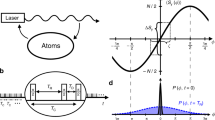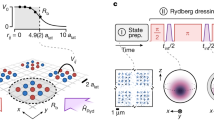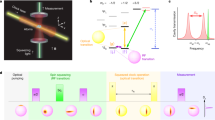Abstract
Building scalable quantum systems that demonstrate performance enhancement based on entanglement is a major goal in quantum computing and metrology. The main challenge arises from the fragility of entanglement in large quantum systems. Optical atomic clocks utilizing a large number of atoms have pushed the frontier of measurement science, building on precise engineering of quantum states and control of atomic interactions. However, state-of-the-art optical atomic clocks are limited by a fundamental source of noise stemming from fluctuations of the population of many atoms—the quantum projection noise. Here, we present an optical clock platform integrated with collective strong-coupling cavity quantum electrodynamics for quantum non-demolition measurements. Optimizing the competition between spin measurement precision and loss of coherence, we measure a metrological enhancement for a large ensemble of atoms beyond the initial coherent spin state. Furthermore, a movable lattice allows the cavity to individually address two independent subensembles, enabling us to spin squeeze two clock ensembles successively and compare their performance without the influence of clock laser noise. Although the clock comparison remains above the effective standard quantum limit, the performance directly verifies 1.9(2) dB clock stability enhancement at the 10−17 level without subtracting any technical noise contributions.
This is a preview of subscription content, access via your institution
Access options
Access Nature and 54 other Nature Portfolio journals
Get Nature+, our best-value online-access subscription
$29.99 / 30 days
cancel any time
Subscribe to this journal
Receive 12 print issues and online access
$209.00 per year
only $17.42 per issue
Buy this article
- Purchase on Springer Link
- Instant access to full article PDF
Prices may be subject to local taxes which are calculated during checkout




Similar content being viewed by others
Data availability
The experimental data presented in this article are available from the corresponding author upon reasonable request. Source data are provided with this paper.
Code availability
The code used for analysis and simulation in this work is available from the corresponding author upon reasonable request.
References
Bothwell, T. et al. JILA SrI optical lattice clock with uncertainty of 2.0 × 10−18. Metrologia 56, 065004 (2019).
Brewer, S. M. et al. 27Al+ quantum-logic clock with a systematic uncertainty below 10−18. Phys. Rev. Lett. 123, 033201 (2019).
McGrew, W. F. et al. Atomic clock performance enabling geodesy below the centimetre level. Nature 564, 87–90 (2018).
Beloy, K. et al. Frequency ratio measurements at 18-digit accuracy using an optical clock network. Nature 591, 564–569 (2021).
Roberts, B. M. et al. Search for transient variations of the fine structure constant and dark matter using fiber-linked optical atomic clocks. New J. Phys. 22, 093010 (2020).
Sanner, C. et al. Optical clock comparison for Lorentz symmetry testing. Nature 567, 204–208 (2019).
Kennedy, C. J. et al. Precision metrology meets cosmology: improved constraints on ultralight dark matter from atom-cavity frequency comparisons. Phys. Rev. Lett. 125, 201302 (2020).
Takamoto, M. et al. Test of general relativity by a pair of transportable optical lattice clocks. Nat. Photonics 14, 411–415 (2020).
Schine, N., Young, A. W., Eckner, W. J., Martin, M. J. & Kaufman, A. M. Long-lived Bell states in an array of optical clock qubits. Nat. Phys. 18, 1067–1073 (2022).
Bothwell, T. et al. Resolving the gravitational redshift across a millimetre-scale atomic sample. Nature 602, 420–424 (2022).
Itano, W. M. et al. Quantum projection noise: population fluctuations in two-level systems. Phys. Rev. A 47, 3554–3570 (1993).
Al-Masoudi, A., Dörscher, S., Häfner, S., Sterr, U. & Lisdat, C. Noise and instability of an optical lattice clock. Phys. Rev. A 92, 063814 (2015).
Aeppli, A. et al. Hamiltonian engineering of spin-orbit-coupled fermions in a Wannier–Stark optical lattice clock. Sci. Adv. 8, eadc9242 (2022).
Marti, G. E. et al. Imaging optical frequencies with 100 μHz precision and 1.1 μm resolution. Phys. Rev. Lett. 120, 103201 (2018).
Oelker, E. et al. Demonstration of 4.8 × 10−17 stability at 1 s for two independent optical clocks. Nat. Photonics 13, 714–719 (2019).
Giovannetti, V. et al. Advances in quantum metrology. Nat. Photonics 5, 222 (2011).
Polzik, E. S. et al. Entanglement and spin squeezing in a network of distant optical lattice clocks. Phys. Rev. A 93, 021404 (2016).
Wineland, D. J., Bollinger, J. J., Itano, W. M., Moore, F. L. & Heinzen, D. J. Spin squeezing and reduced quantum noise in spectroscopy. Phys. Rev. A 46, R6797–R6800 (1992).
Kitagawa, M. & Ueda, M. Squeezed spin states. Phys. Rev. A 47, 5138–5143 (1993).
Appel, J. et al. Mesoscopic atomic entanglement for precision measurements beyond the standard quantum limit. Proc. Natl Acad. Sci. USA 106, 10960–10965 (2009).
Leroux, I. D., Schleier-Smith, M. H. & Vuletić, V. Implementation of cavity squeezing of a collective atomic spin. Phys. Rev. Lett. 104, 073602 (2010).
Leroux, I. D., Schleier-Smith, M. H. & Vuletić, V. Orientation-dependent entanglement lifetime in a squeezed atomic clock. Phys. Rev. Lett. 104, 250801 (2010).
Schleier-Smith, M. H., Leroux, I. D. & Vuletić, V. States of an ensemble of two-level atoms with reduced quantum uncertainty. Phys. Rev. Lett. 104, 073604 (2010).
Chen, Z., Bohnet, J. G., Sankar, S. R., Dai, J. & Thompson, J. K. Conditional spin squeezing of a large ensemble via the vacuum Rabi splitting. Phys. Rev. Lett. 106, 133601 (2011).
Cox, K. C., Greve, G. P., Weiner, J. M. & Thompson, J. K. Deterministic squeezed states with collective measurements and feedback. Phys. Rev. Lett. 116, 093602 (2016).
Hosten, O., Engelsen, N. J., Krishnakumar, R. & Kasevich, M. A. Measurement noise 100 times lower than the quantum-projection limit using entangled atoms. Nature 529, 505–508 (2016).
Pezzè, L., Smerzi, A., Oberthaler, M. K., Schmied, R. & Treutlein, P. Quantum metrology with nonclassical states of atomic ensembles. Rev. Mod. Phys. 90, 035005 (2018).
Nichol, B. C. et al. An elementary quantum network of entangled optical atomic clocks. Nature 609, 689–694 (2022).
Marciniak, C. D. et al. Optimal metrology with programmable quantum sensors. Nature 603, 604–609 (2022).
Wasilewski, W. et al. Quantum noise limited and entanglement-assisted magnetometry. Phys. Rev. Lett. 104, 133601 (2010).
Greve, G. P., Luo, C., Wu, B. & Thompson, J. K. Entanglement-enhanced matter-wave interferometry in a high-finesse cavity. Preprint at arxiv.org/abs/2110.14027 (2021).
Malia, B. K., Wu, Y., Martínez-Rincón, J. & Kasevich, M. A. Distributed quantum sensing with mode-entangled spin-squeezed atomic states. Nature 612, 661–665 (2022).
Weyers, S. et al. Advances in the accuracy, stability, and reliability of the PTB primary fountain clocks. Metrologia 55, 789–805 (2018).
Pedrozo-Peñafiel, E. et al. Entanglement on an optical atomic-clock transition. Nature 588, 414–418 (2020).
Zheng, X. et al. Differential clock comparisons with a multiplexed optical lattice clock. Nature 602, 425–430 (2022).
Bowden, W., Vianello, A., Hill, I. R., Schioppo, M. & Hobson, R. Improving the q factor of an optical atomic clock using quantum nondemolition measurement. Phys. Rev. X 10, 041052 (2020).
Colombo, S., Pedrozo-Peñafiel, E. & Vuletić, V. Entanglement-enhanced optical atomic clocks. Appl. Phys. Lett. 121, 210502 (2022).
Matei, D. G. et al. 1.5 μm lasers with sub-10 mHz linewidth. Phys. Rev. Lett. 118, 263202 (2017).
Norcia, M. A. & Thompson, J. K. Strong coupling on a forbidden transition in strontium and nondestructive atom counting. Phys. Rev. A 93, 023804 (2016).
Hood, C. J., Chapman, M. S., Lynn, T. W. & Kimble, H. J. Real-time cavity QED with single atoms. Phys. Rev. Lett. 80, 4157–4160 (1998).
Hu, J., Chen, W., Vendeiro, Z., Zhang, H. & Vuletić, V. Entangled collective-spin states of atomic ensembles under nonuniform atom-light interaction. Phys. Rev. A 92, 063816 (2015).
Schleier-Smith, M. Cavity-enabled Spin Squeezing for a Quantum-enhanced Atomic Clock. PhD thesis, Massachusetts Institute of Technology (2011).
Braverman, B. et al. Near-unitary spin squeezing in 171Yb. Phys. Rev. Lett. 122, 223203 (2019).
Kolkowitz, S. et al. Gravitational wave detection with optical lattice atomic clocks. Phys. Rev. D. 94, 124043 (2016).
Kómár, P. et al. A quantum network of clocks. Nat. Phys. 10, 582–587 (2014).
Davis, E., Bentsen, G. & Schleier-Smith, M. Approaching the Heisenberg limit without single-particle detection. Phys. Rev. Lett. 116, 053601 (2016).
Kaubruegger, R., Vasilyev, D. V., Schulte, M., Hammerer, K. & Zoller, P. Quantum variational optimization of Ramsey interferometry and atomic clocks. Phys. Rev. X 11, 041045 (2021).
Colombo, S. et al. Time-reversal-based quantum metrology with many-body entangled states. Nat. Phys. 18, 925–930 (2022).
Pezzè, L. & Smerzi, A. Quantum phase estimation algorithm with Gaussian spin states. PRX Quantum 2, 040301 (2021).
Zhang, X. et al. Spectroscopic observation of SU(N)-symmetric interactions in Sr orbital magnetism. Science 345, 1467–1473 (2014).
Bromley, S. L. et al. Dynamics of interacting fermions under spin–orbit coupling in an optical lattice clock. Nat. Phys. 14, 399–404 (2018).
Muniz, J. A. et al. Exploring dynamical phase transitions with cold atoms in an optical cavity. Nature 580, 602–607 (2020).
Vaidya, V. D. et al. Tunable-range, photon-mediated atomic interactions in multimode cavity qed. Phys. Rev. X 8, 011002 (2018).
Davis, E. J. et al. Protecting spin coherence in a tunable Heisenberg model. Phys. Rev. Lett. 125, 060402 (2020).
Dogra, N. et al. Dissipation-induced structural instability and chiral dynamics in a quantum gas. Science 366, 1496–1499 (2019).
Sauer, J., Fortier, K., Chang, M., Hamley, C. & Chapman, M. Cavity QED with optically transported atoms. Phys. Rev. A 69, 051804 (2004).
Chen, Z., Bohnet, J. G., Weiner, J. M., Cox, K. C. & Thompson, J. K. Cavity-aided nondemolition measurements for atom counting and spin squeezing. Phys. Rev. A 89, 043837 (2014).
Acknowledgements
We acknowledge funding support from National Science Foundation QLCI OMA-2016244, Department of Energy National Quantum Information Science Research Center – Quantum Systems Accelerator, Air Force Office for Scientific Research, DARPA, Vannevar Bush Faculty Fellowship, National Institute of Standards and Technology, and National Science Foundation Phys-1734006. M.M. acknowledges the NSF Graduate Research Fellowship. We gratefully acknowledge early technical contributions and discussions from J. Meyer, J. Uhrich and E. Oelker. We acknowledge A. Aeppli, K. Kim, C. Sanner, R. Hutson, W. Milner and L. Yan for many stimulating discussions. We thank A. M. Rey, C. Luo, E. Polzik, V. Vuletic`, J. Hall, M. Schleier-Smith and M. Kasevich for careful reading of the manuscript.
Author information
Authors and Affiliations
Contributions
All authors contributed to the design and operation of the experiment and data analysis and writing of the manuscript.
Corresponding authors
Ethics declarations
Competing interests
The authors declare no competing interests.
Peer review
Peer review information
Nature Physics thanks Luca Pezze and the other, anonymous, reviewer(s) for their contribution to the peer review of this work.
Additional information
Publisher’s note Springer Nature remains neutral with regard to jurisdictional claims in published maps and institutional affiliations.
Extended data
Extended Data Fig. 1 Independence of atomic ensembles.
a, Measured correlation coefficient between Jz,A and Jz,B versus the separation between the ensembles. (black circles). The blue line is a Monte Carlo simulation. b, Corresponding change of the QPN due to the finite overlap of the ensembles, with numerical Monte Carlo simulation (blue) and analytical calculation (orange). At our operating ensemble separation, the change to QPN is 0.04 dB.
Extended Data Fig. 2 Pulse sequence for SSS - SSS comparison.
a, Clock pulses are the black pulses, measurements of ensemble A are the red pulses, and the transports are shown as the green and purple pulses. The Bloch spheres depict the spin state distribution at various points during the sequence. We note that the phase evolution is exaggerated for clarity. b, Ramsey fringe measured by varying the phase of the final π/2 pulse. c, Pre and final measurements of ensemble A. d, Pre and final measurements of ensemble B. e, The final measurements of ensemble A and B show strong correlations, allowing for the subtraction of the common-mode laser phase noise. The data in panels (b-e) correspond to the raw data corresponding to the SSS-SSS comparison shown in Fig. 4b.
Source data
Source Data Fig. 1
Source data underlying Fig. 1.
Source Data Fig. 2
Source data underlying Fig. 2.
Source Data Fig. 3
Source data underlying Fig. 3.
Source Data Fig. 4
Source data underlying Fig. 4.
Rights and permissions
Springer Nature or its licensor (e.g. a society or other partner) holds exclusive rights to this article under a publishing agreement with the author(s) or other rightsholder(s); author self-archiving of the accepted manuscript version of this article is solely governed by the terms of such publishing agreement and applicable law.
About this article
Cite this article
Robinson, J.M., Miklos, M., Tso, Y.M. et al. Direct comparison of two spin-squeezed optical clock ensembles at the 10−17 level. Nat. Phys. 20, 208–213 (2024). https://doi.org/10.1038/s41567-023-02310-1
Received:
Accepted:
Published:
Issue Date:
DOI: https://doi.org/10.1038/s41567-023-02310-1
This article is cited by
-
Collectively enhanced Ramsey readout by cavity sub- to superradiant transition
Nature Communications (2024)
-
Graph states of atomic ensembles engineered by photon-mediated entanglement
Nature Physics (2024)



